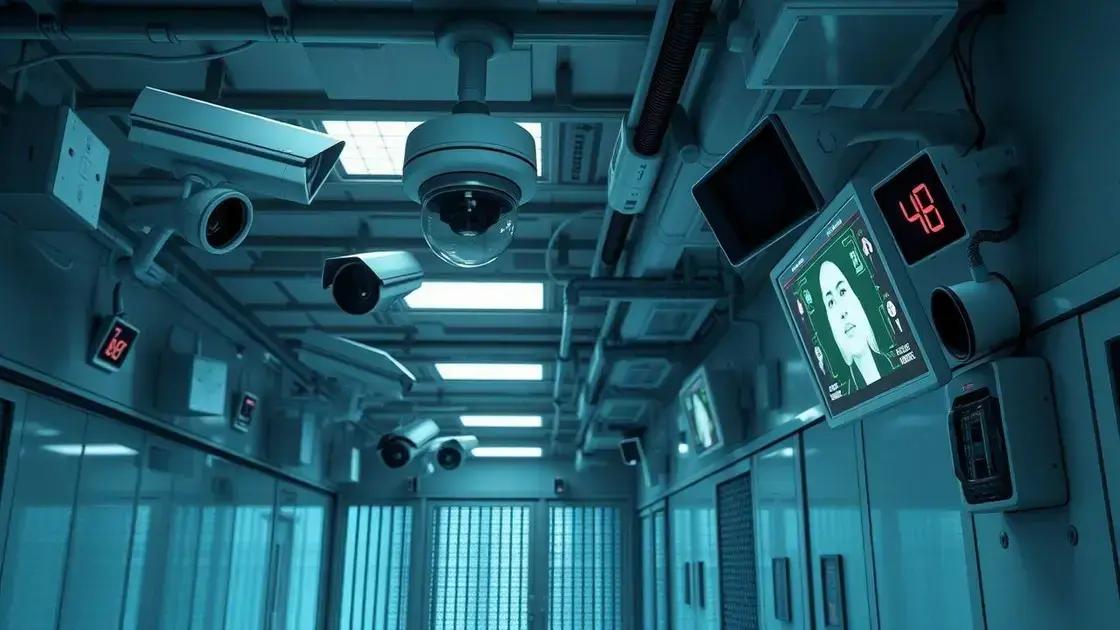A look inside El Salvador’s high-security CECOT prison

Anúncios
A look inside El Salvador’s high-security CECOT prison reveals critical issues such as overcrowding, mental health impacts, and the need for significant prison reform to improve conditions and reduce recidivism.
A look inside El Salvador’s high-security CECOT prison offers a glimpse into an environment designed to contain some of the most dangerous criminals. Have you ever wondered what life is like within these walls? Let’s explore this complex world together.
Anúncios
Understanding CECOT’s security measures
Understanding the security measures at CECOT prison is crucial. This facility employs advanced technology and rigorous protocols. Inmates are monitored 24/7, which deters escape attempts and maintains order.
Key Security Features
Several key features make CECOT one of the most secure prisons in El Salvador. These include:
Anúncios
- High walls and fencing: Designed to prevent escapes, these structures are fortified and tower high above.
- Surveillance systems: Cameras and motion sensors are placed throughout the prison, ensuring constant monitoring.
- Controlled access: All entries and exits are strictly monitored to prevent unauthorized access.
- Staff training: Guards receive specialized training to effectively manage high-risk inmates.
The combination of these features creates a formidable barrier against crime and chaos within the prison.
Technological Innovations
Technology plays a vital role in maintaining security. Integrated systems provide live feed and analytics to prison staff. This allows them to respond quickly to any incidents. For instance, communication devices enable quick alerts in emergencies.
Additionally, the use of biometric systems enhances security. Fingerprint scanners and facial recognition technology help verify identities and prevent impersonation. Such innovations ensure a safer environment for both staff and inmates. Understanding these measures reveals the extensive planning behind confinement in a high-security setting.
Life inside CECOT prison
Life inside CECOT prison is unlike any other. Inmates face strict routines and limited freedoms. Each day follows a schedule, with time allocated for various activities.
Daily Routine of Inmates
Inmates typically wake up early, as the day is tightly controlled. Breakfast is served, followed by time for exercise or work. Each schedule is designed for security while providing some structure.
- Morning activities: Inmates can participate in physical exercise, which helps maintain their health.
- Work assignments: Many inmates have jobs that contribute to the prison’s upkeep, such as cleaning or cooking.
- Education programs: Some inmates access educational resources to learn new skills.
Afternoons often involve more supervised activities, like group therapy sessions or recreation time.
The Challenges of Confinement
Living in a high-security facility brings unique challenges. Inmates may struggle with isolation and stress. Mental health support is essential in this environment. Access to counselors can help inmates cope with their circumstances.
Even within the prison, friendships can form, offering support and camaraderie. Many inmates find ways to connect, despite the strict environment. Shared experiences create bonds that can last during and after their time in prison.
In conclusion, life inside CECOT prison is a blend of routine and challenges. Understanding these dynamics is crucial for anyone looking to grasp the realities of incarceration.
The role of technology in prison security

The role of technology in prison security is critical. Modern facilities like CECOT rely on cutting-edge tools to maintain order and safety. Technology enhances surveillance, communication, and inmate management, making it easier for staff to oversee operations.
Enhanced Surveillance Systems
High-definition cameras are strategically placed throughout the prison. These cameras provide live feeds and can record activities for later review. This constant monitoring helps deter misconduct and maintain a secure environment.
- Infrared sensors: These are used in dark areas to detect movement, ensuring no unauthorized activities occur.
- Facial recognition technology: This enables staff to quickly identify inmates and verify their identities during interactions.
- Drones: In some facilities, drones are used for aerial surveillance, giving guards a bird’s-eye view of potential trouble spots.
These systems work together to create a comprehensive security network.
Communication and Response
Technology also plays a vital role in communication among staff. Walkie-talkies and secure communication apps ensure that guards can quickly share information. This immediacy is crucial during emergencies.
Automated alerts are sent to staff in case of a security breach or disturbance. This allows them to respond swiftly and efficiently, minimizing risks to everyone involved.
Overall, the integration of technology in prison security enhances the safety and efficiency of daily operations. Staff members can focus on maintaining a secure environment while technology helps monitor and manage the facility.
Impact of incarceration on inmates’ mental health
The impact of incarceration on inmates’ mental health is significant and often alarming. Being in a high-security environment like CECOT can lead to various psychological issues. Many inmates experience anxiety, depression, and other mental health challenges.
Common Mental Health Issues
Incarceration can exacerbate existing mental health problems or trigger new ones. Some common issues include:
- Anxiety disorders: Many inmates feel constant fear and worry about their safety.
- Depression: The isolation and lack of support can lead to feelings of hopelessness.
- Post-Traumatic Stress Disorder (PTSD): Past traumas can resurface in prison, affecting mental well-being.
- Substance abuse: Some inmates turn to drugs or alcohol to cope with their circumstances.
The confined environment additionally limits access to resources that support mental health. Inmates may not receive the counseling they need.
Support Systems and Resources
Despite the challenges, some facilities strive to provide mental health support. Access to mental health professionals is crucial. Counselors can help inmates cope with their feelings and provide coping strategies.
Group therapy sessions can also be beneficial. They create a sense of community among inmates, allowing them to share their experiences. This sharing can be a powerful tool for healing.
Overall, understanding the impact of incarceration on inmates’ mental health highlights the need for comprehensive mental health services within prisons. Improving access to care is essential for rehabilitation.
Future of prison reform in El Salvador
The future of prison reform in El Salvador is a critical topic that has gained attention in recent years. With overcrowded facilities and high rates of recidivism, there is an urgent need for change. Addressing these issues is essential for creating a more effective and humane system.
Current Challenges
El Salvador’s prison system faces numerous challenges. Overcrowding remains one of the most pressing issues. Many facilities operate well beyond their intended capacity, which creates unsafe conditions for both inmates and staff.
- Lack of resources: Facilities often struggle with insufficient funding for basic services such as healthcare and rehabilitation programs.
- High recidivism rates: Without proper rehabilitation, many inmates return to crime after release.
- Inadequate staff training: Staff members may not receive the necessary training to handle the complexities of inmate management.
These challenges highlight the need for reform and innovative solutions.
Proposed Changes
Experts suggest that future reforms should focus on several key areas. Increasing funding for rehabilitation programs is vital. These programs can help equip inmates with skills that aid in reintegration into society.
Additionally, improving mental health services is crucial. Many inmates struggle with mental illness, and access to proper treatment can greatly affect their rehabilitation outcomes. Alternatives to incarceration for non-violent offenses are also being discussed. Implementing community-based programs could reduce the prison population.
Ultimately, the future of prison reform in El Salvador hinges on the commitment of lawmakers, society, and rehabilitation experts. By addressing the current challenges and focusing on comprehensive solutions, significant improvements can be made.





